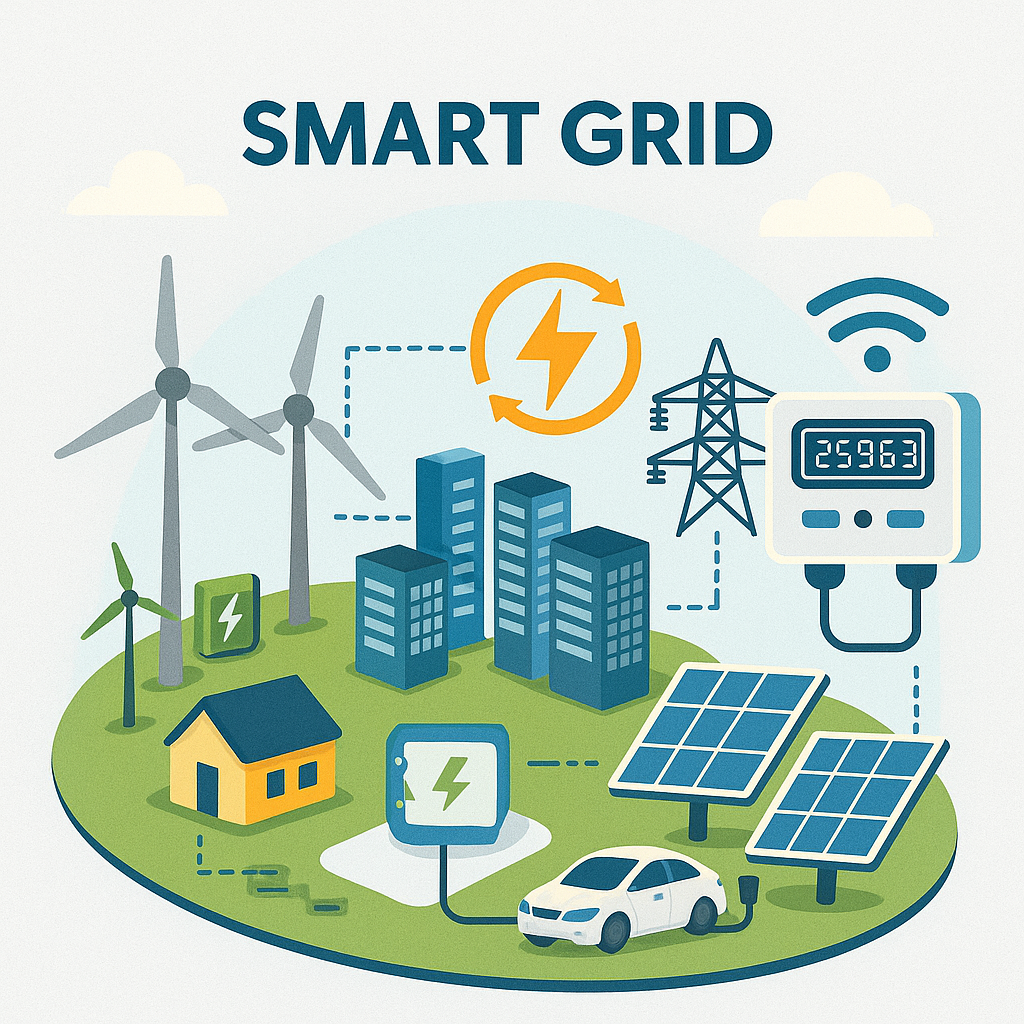Table of Contents
ToggleThe world is rapidly changing the way we produce, consume, and innovate around electricity. In the same way traditional grids are upgraded to smart grid systems. Traditional power grids are less efficient, less intelligent, and less reliable. That’s where smart grid systems come in
In this article, we explore how smart grids work, their advantages, and how they’re shaping the future of electrical technology.
What Is a Smart Grid System?
A smart grid system is an updated version of a traditional power grid. Smart grids include advanced sensors and two-way communication to monitor and manage electricity more effectively and efficiently. The old system, where power flows in one direction—from power plants to homes. On the other hand, the smart grid system is communicative and allows electricity to move in both directions and responds instantly to adjustments in supply, demand, or outages.
Why the Old Grid Isn’t Enough Anymore
Many countries still rely on power grids that were built for a different era—centralized, rigid, and mostly fossil-fueled. But now, with the rise in using solar panels, electric vehicles, wind turbines, and other innovations, the grid needs to be more flexible and advanced. The smart grid system can handle millions of devices generating and using power at different times.
Main Key Features of a Smart Grid System
- Smart grids enable real-time monitoring in which sensors detect outages and voltage issues, as well as grid stress, instantly.
- It enables two-way communication in which data is sent and received by both utilities and users.
- Smart grids have self-healing capabilities that allow them to automatically reroute power around problems, reducing blackouts.
- Smart grid have distributed energy integration that allow to solar panels on rooftops and wind turbines to plug directly into the grids
- Smart grids have Advanced Metering Infrastructure (AMI) that allows them to give real-time usage data to both consumers and providers.
Latest Scientific Innovations Powering Smart Grids
- Demand flexibility—moving energy use to more cost-effective and environmentally friendly times—is being tested in a £5.3 million UK trial. To lower bills and ease the strain on the grid, retired users like John and Barbara Hall utilize an app connected to smart meters. With estimated national savings of £14 billion and household savings of up to £375 annually by 2040, experts call it crucial for a net-zero future.
- Smart grid resilience is rapidly improving grid reliability, efficiency, and sustainability in energy systems. Emerging technologies are transforming grid resilience as utilities face aging infrastructure, rising energy demand, and extreme weather. The smart grid market is projected to grow from $71.3B in 2024 to $216.4B by 2032, with resilience tech alone reaching $79.6B. Innovations like HVDC, DERs, energy storage, and real-time monitoring are improving reliability, reducing outages, and enabling better integration of renewables. Companies like Siemens, GE, and Schneider Electric are leading this shift toward smarter, adaptive energy systems—making grid resilience a key driver of a stable, low-carbon future.
How Smart Grids Work—In simple
In summer there are a lot of air conditioners running at once; if these are connected to the traditional grid, the traditional grid can’t handle it, and this causes strain and risks outages. But on a smart grid:
- Usage is continuously monitored.
- Smart grids automatically shift power from power storage or renewables.
- It can reduce demand by signaling smart appliances to lower consumption temporarily.
- If there’s a short circuit or any failure, it can reroute electricity around it without any human intervention.
All of this happens digitally, within a few seconds.
Smart Grid Benefits
1. Fewer Outages, Faster Fixes
Advanced sensors and automated switches detect problems immediately and reroute power. You won’t have to wait for hours to identify the issue.
2. Fewer Energy Waste
Smart grids predict load demand and efficiency, which causes less power to be lost during transmission and distribution.
3. Clean Energy Mix
Smart grids allow the integration of renewable energy sources, assisting countries in achieving their environmental targets.
4. Cost Savings
Both users and suppliers can save money with real-time data. Utilities can operate more efficiently, and consumers can avoid paying during peak hours.
5. Energy Independence
Smart grids make it easier for buildings, communities, or cities to produce and manage their own power.
Real-World Use Cases
1. United States:
According to the latest report, North America has installed 146 million smart meters, and 130.6 million are in the US. After installing smart meters, electricity loss rates drop by 4–7%, and outage lengths are shortened by 5.5%.
American companies like Duke Energy, along with startups like Rhizome, are now using AI to anticipate equipment failure, frequently reducing storm-related outages by as much as 72%.
2. Germany:
In April 2025, Germany produced 11,920 GWh, a 31% rise year-over-year, making up 32% of generation by solar power. Germany to expand battery storage (over 6 GWh added per year), implement demand-response projects, and also upgrade smart grid infrastructure to manage renewables in a better way.
Germany main projects, like Korridor B and the upcoming A‑Nord DC link, are improving transmission capacity, specifically for connecting industrial areas with wind energy from the north.
2. Pakistan:
Research proposes that in Pakistan energy losses were reported of up to ₹90 billion over five years by 2013, but LESCO is experimenting with two-way digital communication to improve transparency and reduce losses.
The Problems Smart Grids Haven’t Solved Yet
- Cybersecurity: Smart grids are completely digital systems, and like any digital system, there is a chance of being hacked. More digital systems mean more potential attack points.
- Initial Costs: Upgrading infrastructure isn’t cheap; switching from traditional to smart grids required high initial costs.
- Data Privacy: Smart meters collect detailed usage data—raising concerns.
- Standardization: Different regions and vendors may use incompatible tech.
Still, none of these are deal-breakers. They’re part of the evolution.
Smart Grid VS Traditional Grid
| Feature | Traditional Grid | Smart Grid |
|---|---|---|
| Power Flow | One-way | Two-way |
| Outage Response | Manual, slow | Automated, fast |
| User Feedback | Monthly bill only | Real-time via apps/meters |
| Renewable Integration | Limited | Built for it |
| Efficiency | Moderate | High |
Final Thoughts
Smart grid systems are the future of energy. They improve the reliability, effectiveness, and cleanliness of our entire power system.
Governments, utility companies, and tech developers are already investing heavily in smart grid systems. As more countries and companies move toward clean energy, smart grids will become the backbone of it all.
Smart grids are modernizing how we live, work, and power the world.
- Smart Grid Systems Explained: How They Work and Why They Matter - August 2, 2025
- Make ChatGPT Smarter: 7 Practical Ways to Get Better Results - July 24, 2025
- Best Free SEO Tool: One Smart Platform to Rank Faster - July 21, 2025







